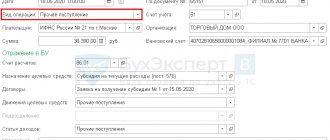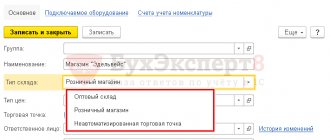On the difference between the concepts of “acceptance for accounting” and “receipt of goods”
Why does an accountant need to look at the contract for the purchase of goods? Firstly, in order to correctly determine the moment of acceptance of the goods for registration, which directly depends on the terms of the concluded contract. I'll explain how.
The fact is that it is necessary to reflect the purchased goods on account 41 “Goods” exactly when the ownership of it has transferred to the organization. Goods that do not belong to it are recorded in off-balance sheet accounts.
When does the buyer acquire ownership? Article 223 of the Civil Code states that, unless otherwise specified in the contract, this right arises from the moment of transfer of the thing. But what is meant by such a transfer is defined in Article 224. This is the delivery of the thing to the purchaser, as well as delivery to the carrier for sending to the purchaser or delivery to a communications organization for sending the thing to the purchaser. Or, more simply put, the transfer of the item to the buyer or the first carrier.
There are similar rules in Chapter 30 of the Civil Code, dedicated to purchase and sale. Article 458 states that the seller's obligation to deliver the goods is considered fulfilled when the goods are delivered to the buyer or handed over to the first carrier. Again, unless otherwise provided in the purchase and sale agreement itself.
As you can see, in all cases, the moment of transfer of ownership, and therefore the moment when the goods must be accepted for accounting, will depend on what is written in the sales contract.
And since we are talking about accepting goods for accounting, let’s immediately clarify what we mean by it. After all, not a single regulatory document provides an official definition of this extremely important term.
Accounting for transactions with goods is regulated by the same basic documents as accounting for any inventories. These are PBU 5/01 “Accounting for inventories” and Guidelines for their accounting, approved by Order of the Ministry of Finance N 119n. There are, of course, also special documents that are intended only for organizations specializing in trade, but we will talk about them later.
So, if we open PBU 5/01 with you, we will read in it that inventories are taken into account. And if we open the Methodological Instructions for Accounting for Inventory, we will see that in many sections of this document we are talking about their capitalization. What's the difference?
I believe that registration should be understood as legal control over a product, that is, the transfer of ownership of it, regardless of where it is physically located. For example, goods in Magadan are shipped to the first carrier. Now, the goods were loaded onto the ship, and, unless otherwise agreed in the contract with the buyer, who is the owner of the goods at this moment? He has already become a buyer, although he has not seen the product in person. And therefore, at this moment, the buyer is obliged to accept this product for his account, despite the fact that he does not physically have the product.
And when I say “posting,” I mean transferring the goods under reporting to the financially responsible person who is responsible for its safety. As soon as the goods are loaded, for example, onto a ship, the carrier is responsible for its safety. Once it has been transferred to the buyer's warehouse, the financially responsible person who received it is responsible for the safety of the goods. And you need to capitalize the goods when you gain physical control over them. This means that other people’s goods can also be capitalized. For example, accepted for commission or safekeeping. They will need to be reflected in off-balance sheet accounts.
That is, in accounting, transactions involving the movement of goods are reflected based on who the owner is (acceptance of registration), and based on where the goods are physically located and who bears the risk of its destruction or loss (posting).
By the way, confirmation that these transactions reflect various independent facts of economic activity can be found in the Civil Code. If we look at Articles 211 and 459, which deal with the risks of accidental loss of property, it becomes clear that the person who owns it does not necessarily bear the risks of its loss. In other words, ownership of a product does not always pass to the buyer simultaneously with the risk of its loss or damage. This means that this will be reflected in accounting at different times.
First published in the publication “General Book. Conference Hall” 2011, No. 06
Products Accounting Tax Accounting
Accounting for Goods Accounting for Goods on Commission Accounting for Materials VAT Tax Audits
Universal Transfer Document
Products – Accounting and Tax Accounting, TTN
Acceptance and Shipment of Goods, TTN
The organization must register the goods on the day of transfer of ownership of it, on the day of its actual receipt, as evidenced by the date of receipt of the goods, stamped on the invoice, regardless of what date the invoice was issued.
Under a sales contract, the seller undertakes to transfer ownership of the goods to the buyer, and the buyer undertakes to accept the goods and pay a certain amount of money for them.
The seller’s obligation to transfer the goods to the buyer is considered fulfilled at the moment of delivery of the goods to the buyer or the person indicated by him, if the contract provides for the seller’s obligation to deliver the goods.
The acquirer's right of ownership under the contract arises from the moment of its transfer, unless otherwise provided by law or contract.
In accordance with Law N 402-FZ, each fact of economic life is subject to registration as a primary document. The primary accounting document must be drawn up at the time of the transaction, and if this is not possible, immediately after its completion.
The moment of actual shipment of the goods by the seller must coincide with the date of drawing up the primary document.
A consignment note is used to formalize the sale (release) of inventory items to a third party. It is drawn up by the seller in two copies.
The first remains in the organization handing over the inventory items and is the basis for their write-off.
The second copy is transferred to the buyer and is the basis for the recording of these valuables.
. .
When developing the form for your consignment note, form N TORG-12 can be taken as a basis, which contains, in particular:
- “Date of compilation” detail, which is filled in by the supplier;
- details filled in by the consignee at the time of receipt of the cargo;
- details “The cargo was accepted by the consignee”,
- "M.P." and date.
In the “Date of Compilation” column, the date of preparation of the document must be entered, reflecting the shipment of the goods. In the date column located under the requisite “The cargo was accepted by the consignee”, the date of acceptance by the buyer of the goods delivered to him is entered. Depending on delivery conditions, these dates may vary.
If the date of drawing up the invoice precedes the date of transfer of the goods, this does not mean that the buyer accepted the goods on the day the invoice was drawn up, since the date of acceptance of the goods is an independent detail and is indicated separately under the consignee’s signature on acceptance of the goods.
The time the goods spend in transit is determined by waybills.
A consignment note is issued when goods are delivered by road. The form of the consignment note (form N 1-T) was approved by Resolution of the State Statistics Committee N 78.
Along with the consignment note, the form of the consignment note (TN) is used, approved by Decree of the Government of the Russian Federation N 272.
When accepting goods for accounting, an act of acceptance of goods should be drawn up (the unified form N TORG-1, approved by Resolution of the State Statistics Committee of Russia N 132, can be used).
The date of drawing up the Act must correspond to the date of receipt of the goods indicated in the TORG-12 invoice.
The act is drawn up in one copy on the day the goods are received and is signed by members of the commission, storekeeper, chief accountant and approved by the head of the organization.
If goods are purchased by an organization as raw materials for further use in the production of products, then the posting of goods to the warehouse can be issued by a receipt order drawn up on the basis of Form N M-4.
Accounting
Accounting for goods is regulated by the norms of PBU 5/01 “Accounting for inventories” and Methodological guidelines.
Goods are accepted for accounting at actual cost, which, when purchasing goods for a fee, recognizes the amount of the organization's actual costs for its acquisition, excluding VAT and other refundable taxes.
The receipt of goods in accounting is reflected by the following entries:
Debit 41 Credit 60 - the receipt of goods is reflected; Debit 19 Credit 60 - VAT reflected; Debit 68, subaccount “VAT” Credit 19, subaccount “VAT” - VAT is accepted for deduction. The posting of goods on the date of drawing up the TORG-12 invoice is possible only if the terms of the contract stipulate that ownership of the goods passes to the buyer at the supplier’s warehouse.
If the goods are delivered to the buyer’s warehouse within a certain period of time, this product is taken into account in the buyer’s accounting in account 41 (sub-account “Goods in transit”), and after actual receipt at the warehouse it is transferred to account 41, sub-account “Goods in warehouse”.
VAT
The taxpayer has the right to reduce the amount of VAT by the amounts established by Art. 171 of the Tax Code of the Russian Federation, tax deductions.
VAT amounts are subject to deductions if the following conditions are simultaneously met:
- purchased goods must be accepted for accounting (clause 1 of Article 172 of the Tax Code of the Russian Federation) on the basis of the relevant primary documents;
- goods must be purchased for use in activities subject to VAT;
- in the presence of an invoice issued by the seller of goods (clause 2 of article 169, clause 1 of article 172 of the Tax Code of the Russian Federation).
The moment of acceptance of goods for registration for VAT purposes should be considered the actual date of receipt of goods received by the organization.
VAT amounts presented for the acquisition of material assets that were not actually received by the organization and were not capitalized are not accepted for deduction.
The moment of determining the tax base for VAT is the earliest of the following dates:
- day of shipment (transfer) of goods (works, services), property rights;
- day of payment, partial payment for upcoming deliveries of goods (performance of work, provision of services), transfer of property rights.
The day of shipment of goods (works, services) is the date of the first drawing up of the primary document, which is issued to the buyer or carrier of the goods.
Invoices are issued no later than five calendar days from the date of shipment of the goods.
If the organization has primary documents on the basis of which the goods are registered, the invoice is issued without violations, the goods are used in activities subject to VAT, then the organization can deduct the amount of VAT presented by the supplier.
Tax authorities refuse to deduct amounts of “input” VAT if there are errors in the preparation of primary documents, in particular, if the line “The cargo was received by the consignee” TORG-12 is not completed.
When returning a defective product that has been accepted for registration, an invoice will be issued.
When returning goods accepted by a buyer who is a value added tax taxpayer for registration, the value added tax is not restored.
The buyer issues an invoice to the seller for the returned goods and taxes are charged on the transfer of defective goods.
Letter of the Ministry of Finance No. 03-07-11/51923
Universal Transfer Document
Accounting for Goods Accounting for Goods on Commission Accounting for Materials VAT - New Tax Audits
Economics of Pharmacy Organization of Pharmacy Activities
Receipt of goods to pharmaceutical institutions, including pharmacy organizations, can be carried out directly from manufacturing enterprises, from drug wholesalers.The assortment, quantity and quality, order and timing of shipment and other delivery conditions are determined by supply (purchase and sale) agreements.
Agreements must be drawn up in accordance with the requirements of the Civil Code of the Russian Federation. The pharmacy itself establishes the organization of acceptance, inspection (according to the order of the Ministry of Health of the Russian Federation dated July 16, 1997 No. 214 “On quality control of medicines manufactured in pharmaceutical organizations (pharmacies)” section 2 “Acceptance control”), registration, payment for incoming goods, taking into account the terms of delivery and transportation.
Determines the persons responsible for acceptance of goods. The procedure and place of acceptance of goods depends on the method of receipt. If goods are delivered by the supplier’s transport, then acceptance of the quantity and quality of goods is carried out directly at the pharmacy.
If the pharmacy itself comes to the supplier to pick up the goods, then full acceptance with checking quantity and quality is carried out at the supplier’s warehouse.
Reception of goods shipped by out-of-town suppliers is carried out twice: first - by a forwarder from the transport organization, communication by the number of pieces and gross weight (tare weight), and then - in the enterprise itself by a financially responsible person with a full check of their quantity and quality.
To receive goods from a transport organization or supplier, an authorized person is issued a power of attorney of the established form. A power of attorney is used to formalize the right of a person to act as a trustee of an organization when receiving material assets. The power of attorney is drawn up in one copy by the accounting department and issued to the recipient against signature. The power of attorney is signed by the manager and chief accountant.
The power of attorney is issued indicating the validity period. A power of attorney to receive inventory items in the order of planned deliveries can be issued for 1 calendar month.
When shipping the goods, the supplier writes to the pharmacy:
- settlement documents - invoices, payment requests;
- commodity documents - invoices (form No. Torg-12), invoices;
- tax documents - invoices;
- accompanying documents - certificates of conformity and other documents confirming quality.
Acceptance of goods from the transport organization is carried out taking into account the rules in force in transport and the terms of the supplier’s contract for the carriage of goods. As a rule, the goods in this case are accepted according to the number of pieces and gross weight, reconciliation is made according to the information specified in the waybills.
Based on the results of the reconciliation, a “Goods Acceptance Certificate” is drawn up; if a shortage, breakage, damage, or defect is detected, a “Certificate on the established discrepancy in quantity and quality when accepting inventory items” is drawn up to file a claim with the supplier (sender).
To present claims to a transport organization or communications organization, a special commercial act is drawn up in accordance with the rules in force in these organizations.
Reception of goods directly at the pharmacy or at the supplier’s warehouse - goods are checked on the basis of accompanying documents, by name, quantity and quality.
Reception must be carried out in accordance with the technical conditions, instructions on the procedure for accepting products for industrial and technical purposes and consumer goods in terms of quality and quantity (P-6, P-7), if this acceptance procedure is provided for in the contract.
The labeling is checked to determine the manufacturer, batch numbers, analysis number, documents confirming the quality of the product, and other information. Acceptance of the goods is confirmed by the financially responsible person, with a receipt on the delivery note, or an “Acceptance Stamp” is affixed.
If a discrepancy with the supplier’s documents is detected, acceptance is suspended and conditions are created for the safety of the accepted goods. The supplier is informed about the discrepancy by telephone and the issue of his representative’s departure or the creation of a commission to accept the goods without the supplier’s representative is decided.
Based on the results of acceptance, a “Act on the established discrepancy in quantity and quality when accepting inventory items” is drawn up (the Act can be downloaded from this link).
At the locations and storage locations, received goods for each document are recorded in chronological order in the “Warehouse Goods Log”, or a “Goods Receipt Log” is maintained, departmental and in the incoming part of the “Commodity Report”.
What date should be used to record the arrival of goods at the warehouse according to the return invoice?
In accordance with the provisions of Article 190 of the Tax Code, tax accounting is the process of maintaining accounting documentation by a taxpayer (tax agent) in accordance with the requirements of this Code for the purpose of generalizing and systematizing information about taxable objects and (or) tax-related objects, as well as calculating taxes and payments to the budget and preparation of tax reporting.
At the same time, accounting documentation includes accounting documentation for persons who, in accordance with the Law of the Republic of Kazakhstan “On Accounting and Financial Reporting,” are responsible for its maintenance.
In accordance with the provisions of Article 7 of the Law “On Accounting and Financial Reporting”, accounting documentation includes primary documents, accounting registers, financial statements and accounting policies. Accounting records are made on the basis of primary documents. Forms or requirements for primary documents used to formalize transactions or events are approved by the authorized body and (or) the National Bank of the Republic of Kazakhstan in accordance with the legislation of the Republic of Kazakhstan.
According to paragraph 2 of Article 7 of the Law of the Republic of Kazakhstan “On Accounting and Financial Reporting”, the forms or requirements for primary documents used to document transactions or events are approved by the authorized body and (or) the National Bank of the Republic of Kazakhstan in accordance with the legislation of the Republic of Kazakhstan.
Those. forms and requirements for primary documents are regulated by Order of the Minister of Finance of the Republic of Kazakhstan dated December 20, 2012 No. 562 “On approval of forms of primary accounting documents.”
At the same time, based on the provisions of subparagraph 2) of paragraph 5 of Article 20 of the Law of the Republic of Kazakhstan “On Accounting and Financial Reporting,” the authorized body develops and approves the procedure for maintaining accounting records.
The accounting rules were approved by Order of the Minister of Finance of the Republic of Kazakhstan dated March 31, 2015 No. 241.
Taking into account the provisions of paragraphs 27 and 32 of the Accounting Rules:
— for the acceptance and transfer of completed work (rendered services), with the exception of construction and installation work, an act of completed work (rendered services), form (P-1) of which is approved by Order No. 562, is used, which is drawn up by the contractor to confirm the fact of a business transaction;
— to account for the sale of inventories, an invoice for the release of inventories to the party is used, the form (Z-2) of which is approved by Order No. 562.
Those. The basis for inventory accounting is the invoice.
According to Article 7 of the Law of the Republic of Kazakhstan dated February 28, 2007 No. 234-III “On Accounting and Financial Reporting”, all events and transactions in accounting are reflected on the basis of primary accounting documents compiled at the time of the transaction.
Primary documents must be drawn up at the time of the transaction or event or immediately after its completion.
In this case, the date of receipt of goods will be considered the date established under the terms of the contract or established by the accounting policy of the enterprise in accordance with the requirements of IFRS.
TOP 10 common accounting errors that can result in a fine
The taxpayer, being a tax agent for VAT, does not calculate VAT.
Organizations using the simplified tax system do not pay VAT.
But in some cases they are forced to report VAT. The first case is when importing services from suppliers. For example, some foreign company that does not have a representative office in the Russian Federation provides services to a Russian company. The Russian organization is registered on the territory of the Russian Federation, so the service, in fact, is provided on the territory of the Russian Federation. In this case, the Russian company is a tax agent and, when paying remuneration, must calculate VAT for its supplier.
The second case is when renting real estate from government organizations or government agencies. In this case, organizations applying the simplified tax system are tax agents in relation to these institutions or organizations. The procedure is the same: they need to calculate VAT, pay it to the budget and declare it.
The third case is when organizations using the simplified tax system work under an agency agreement and draw up shipping documents on behalf of the principal, and in these documents allocate VAT and issue an invoice. In this case, they, acting as tax agents, must calculate VAT, pay it and submit a return.
An organization uses the simplified tax system to sell goods, works or services, allocating VAT.
Organizations using the simplified tax system are exempt from paying VAT, but there are cases when they voluntarily calculate VAT in primary documents (issue invoices, pay VAT to the budget). In such cases, organizations mistakenly assume that since they paid VAT to the budget, they have the right to reimburse it from the budget. This is illegal: since they are not a VAT payer, therefore, there can be no talk of any refund. The Ministry of Finance and the Federal Migration Service write a lot about this, however, organizations continue to make this mistake.
When do organizations make these types of mistakes? Let’s say the company’s buyer is a large plant that demands that the supplier be a VAT payer. At the request of the buyer, the supplier allocates VAT for this transaction and pays it to the budget (issues a VAT invoice, issues an invoice with VAT). At the same time, the organization is tempted to refund VAT on the basis of the documents used to purchase the goods. In this case, this cannot be done, since the company pays VAT on sales, but VAT on purchases is not refundable due to the application of the simplified tax system.
The plant, despite the fact that it requires payment of VAT, also does not have the right to a refund of the VAT paid by the organization, since the organization applying the simplified tax system is not a VAT payer. In essence, voluntary payment of VAT is an illegal action. It’s just that the tax authorities don’t punish for this: no one objects if the organization paid the money of its own free will. At the same time, by agreeing to the requirements of large organizations and issuing VAT invoices, organizations, in fact, are setting up their buyer, since he, too, is tempted to refund VAT, to which he has no right.
Companies pay dividends without first paying personal income tax.
When paying wages, mistakes are usually not allowed: personal income tax must be paid either on the day the wages are paid or earlier. But with regard to dividends, for some reason this rule is often forgotten, that is, dividends are paid first, and then, after some time, personal income tax.
Incorrect registration of dividends.
This mistake is especially often made by organizations that are on the simplified tax system.
As you know, since 2013, all legal entities, regardless of taxation, must keep records and submit financial statements. To calculate dividends, they must use these statements, in particular the income statement, which shows the net income to be distributed as dividends. Many organizations make a mistake: they do not use this report and, therefore, distribute not the profit indicated in this report, but the profit that was obtained from the book of income and expenses.
This error entails subsequent errors: if you incorrectly calculated the possible amount of dividends, then you incorrectly calculated the net profit, and, accordingly, paid dividends incorrectly. Often these amounts vary greatly.
Organizations conduct business activities that are not provided for by their OKVED regulations.
It often happens that an organization starts some new type of activity - sales or production of goods, but does not have the right to carry out this activity, because this type of activity is not declared to the tax office.
Before engaging in a new activity, you must submit the appropriate changes to the tax office.
Violations of cash discipline.
Small organizations (especially stores) have a cash register, with which they issue cash receipts, and at the end of the shift they print out a cash summary Z-report. They mistakenly believe that this is the end of processing cash documents, so they do nothing more. In fact, at the end of the cash register shift, you need to issue another cash receipt order and thereby, as it were, complete cash accounting: make an entry about this cash order in the cash book and in the cashier’s report.
Taxpayers who apply the simplified tax system (who have chosen income reduced by the amount of expenses as the tax base) and who carry out trading activities erroneously take into account in tax accounting the cost of goods not at the time of their sale, but immediately after the goods are posted and paid for by the supplier.
Even experienced accountants make this mistake.
When selling goods, we take into account the cost of these goods in expenses if three main conditions are met: these goods are paid to the supplier, capitalized and shipped to the buyer. At the time of shipment to the buyer, if all these three conditions are simultaneously met, we can take into account the cost of these goods in expenses and, accordingly, reduce the taxable base for the tax associated with the use of the simplified tax system. No other way.
Violation of the deadlines for submitting advance reports after the accountable person has made expenses for the purchase of goods, works or services.
The law provides for the ability of the taxpayer to determine the period for which accountable amounts are issued. For example, accountable amounts can be issued for six months, and a person can keep this amount in his pocket for six months, and then make some expenses and report on the advance report. But, as a rule, everyone is watching the first term. At the same time, they often do not follow the second one - after a person has spent part of the money, he must provide an advance report to the accounting department within three working days, and deposit the remaining amount into the cash register as unspent. Often this is not done. In most cases, a person, having spent part of the amount, continues to keep the remaining money with him, mistakenly assuming that he has three more months left.
Companies ship goods earlier than the goods are received. That is, they ship what is not in stock.
This violation is due to various reasons. As a rule, inconsistencies occur due to the fact that documents for goods are issued retroactively, when the goods are purchased and already sold.
By making such a mistake, an organization is not able to write off the cost of this product as an expense in tax accounting. If it was sold before it was purchased, then its cost at the time of sale was zero.
Some directors mistakenly assume that it is impossible to write off money from a current account in favor of the tax office if this account is seized.
The tax office seizes current accounts for commercial payments. But in terms of making budget payments, these accounts remain free. And the mistake of most directors is that they often go to pay taxes at a branch of another bank as an individual. They pay the tax, but the tax office cannot find this payment even if they present a receipt. In such a situation, it will be difficult to prove anything to the tax authorities. Therefore, if the account is frozen, but you need to pay tax, you just need to make the payment from your current account.
Pavel Timokhin , expert at Finguru company
The goods have not been received. The problem of applying VAT deduction
A Russian organization purchased goods from a foreign supplier. According to the terms of the contract, delivery is carried out on CPT terms (according to Incoterms 2000). The place of delivery is the customs post chosen by the supplier. The place and date of delivery are indicated in the transport documents (bill of lading), i.e. The transfer of title is the date of discharge over the ship's rail as stated on the bill of lading. In addition, the buyer has entered into an agreement with a Russian organization (broker), which carries out transport forwarding at the port and at customs, carries out customs clearance of the goods and places them in a temporary storage warehouse. On the date of transfer of ownership, the buyer registered the goods, paid VAT, customs duties and fees, but did not manage to remove all the goods from the broker’s temporary storage warehouse before the end of the tax period.
At the end of the tax period, can the buyer refund VAT in full on goods registered and located in a temporary storage warehouse with a broker in the presence of all primary documents (customs declaration, bill of lading, payment orders for customs duties and VAT)?
According to paragraph 2 of Art.
171 of the Tax Code of the Russian Federation are subject to deductions
, in particular,
those paid by the taxpayer when importing goods into the territory of the Russian Federation
and other territories under its jurisdiction, in customs procedures for release for domestic consumption, temporary import and processing outside the customs territory in relation to goods (work, services), as well as property rights acquired for carrying out operations recognized as objects of VAT taxation, goods (works, services) acquired for resale.
To deduct VAT, the following conditions must be met
:
– actual payment
amounts of VAT when importing goods into the territory of the Russian Federation and other territories under its jurisdiction;
– registration
goods (works, services), property rights.
The latter condition is the subject of heated debate.
The position of the inspectors is as follows.
The moment of acceptance of goods for registration
For VAT purposes,
the actual date of receipt of
goods received by the organization should be considered based on the relevant primary documents.
Thus, VAT amounts presented for the purchase of materials that were not actually received by the organization and were not capitalized are not accepted for deduction.
(letter of the Ministry of Finance of the Russian Federation dated September 26, 2008 No. 03-07-11/318).
Let's figure out what acceptance for accounting means
.
Art. 223 Civil Code of the Russian Federation
It is established that
the right of ownership
of the acquirer of a thing under a contract arises
from the moment of its transfer
, unless otherwise provided by law or contract.
Delivery is the delivery of a thing
to the acquirer,
as well as delivery to a carrier for shipment to the acquirer
or delivery to a communications organization for forwarding to the acquirer of things alienated without the obligation of delivery.
The item is considered delivered
to the acquirer
from the moment
of its actual
receipt into the possession of the acquirer or the person indicated by him
.
The transfer of a bill of lading is equivalent to the transfer of a thing
or another document of title to it (
Article 224 of the Civil Code of the Russian Federation
).
The rules for the formation in accounting of information about an organization’s inventories are established by PBU 5/01 “Accounting for inventories”
, approved by order of the Ministry of Finance of the Russian Federation dated 06/09/2001 No. 44n.
And paragraph 2 of PBU 5/01 states that goods are part of inventories acquired or received from other legal entities or individuals and intended for sale.
Consequently, accounting of goods is carried out according to the rules of PBU 5/01
.
Clause 26 of PBU 5/01 stipulates that inventories owned by the organization but in transit
or transferred to the buyer as collateral,
are taken into account in accounting
in the assessment provided for in the contract, with subsequent clarification of the actual cost.
This means that goods, the ownership of which has transferred to the purchasing organization, but have not yet been received at the organization’s warehouse
, must be accounted for on account 41, to which you have the right to open a separate sub-account, for example, “Goods in transit, recorded at contract value.”
When the actual cost of goods is formed (for example, delivery costs, brokerage fees, etc. will be taken into account), the cost of goods will be clarified.
When goods arrive at the warehouse, the actual cost of goods will be taken into account in account 41 subaccount “Goods in warehouse”.
P. 10 Guidelines for accounting of inventories
, approved by order of the Ministry of Finance of the Russian Federation dated December 28, 2001 No. 119n, it is established that
amounts paid for inventories that have not been removed from suppliers’ warehouses and are in transit are taken into account in accounting in settlement accounts as receivables
.
However, as the Federal Antimonopoly Service of the North Caucasus
District
, this item
applies to inventories that are not at the disposal of the buyer
.
That is , to inventories for which ownership has not passed to the buyer
.
After all, only the owner of this property can dispose of property.
In addition, both PBU 5/01 and clause 10 of the Methodological Instructions provide for the reflection of unaccounted goods in the balance sheet asset
.
And if the organization does not have ownership rights (the right of economic management or operational management, respectively) for the received material assets, the latter must be accounted for in off-balance sheet accounts (Resolution dated October 4, 2005 No. F08-4673/2005-1849A).
It should be noted that earlier officials were also supported by some courts.
.
Thus, the Federal Antimonopoly Service of the Volga Region
in the resolution dated November 1, 2007 No. A57-14388/06, he indicated that the current system of regulatory documents on accounting does not establish the procedure for accepting inventory items for accounting at the moment of transfer of ownership.
PBU 5/01 uses the term “date of acceptance for accounting”, but it is nowhere linked to the moment of transfer of ownership to the buyer
for inventory items.
Inventories, like all other types of assets, are taken into account during the transition to organizing control over them
.
If the right of ownership, economic management or operational management is transferred to controlled inventories, then in accounting the latter should be reflected on the balance sheet (on balance sheet accounts), in other cases (commission, processing, pledge, etc.) inventories will be accounted for corresponding off-balance sheet accounts.
Thus, in order to accept assets for accounting, the primary step is to establish control over them
.
According to the Methodological Guidelines for Accounting for Inventory, establishing control means the receipt of goods at the organization’s warehouse
.
Therefore, regardless of the existence of ownership rights to inventories, if they have not yet arrived at the organization's warehouse
, according to the Methodological Instructions,
they should not be accepted for balance sheet accounting, since control has not been established over them
.
In addition, in the Chart of Accounts there is no mention of the possibility of reflecting goods in transit using account 41.
Thus, the taxpayer does not have the right to take into account in one tax period inventory items that actually arrived at the enterprise’s warehouse in another tax period, and to claim corresponding tax deductions in the disputed tax period (end quote)
.
arbitration practice subsequently
.
Thus, the Federal Antimonopoly Service of the North-Western District
in resolution dated November 1, 2010 No. A52-3413/2009,
rejected the tax inspectorate’s argument that
the taxpayer
VAT for deduction
before the goods actually arrived at the taxpayer’s warehouse.
In accordance with the delivery agreement, ownership of the goods and all risks of accidental loss or accidental damage to the goods are transferred to the buyer from the date of delivery.
Delivery date
goods from
the date of transfer of goods to the carrier
indicated in the delivery note.
The company accepted for accounting the goods in transit
, and claimed
VAT for deduction in those tax periods in which the ownership of the goods was transferred to the taxpayer
.
The basis for reflecting the arrival of goods was invoices.
Receipt orders in form M-4 were drawn up by the company as an internal document for drawing up accounting entries for taking into account material assets in transit.
Consequently, having registered goods in transit, the taxpayer legally applied a VAT deduction in the tax period in which ownership of the goods was transferred to him
.
FAS Volga region
indicated that since
the provisions of Art.
172 of the Tax Code of the Russian Federation do not contain the concepts of “actual receipt of goods”, “receipt of goods into a warehouse” , then the court lawfully did not accept the tax authority’s argument about the validity of applying a VAT deduction only after the actual receipt of goods at the warehouse (receipt of goods) (resolution dated July 15, 2010 No. A55-29172/2009).
According to the FAS Moscow District
,
references
from the tax inspectorate in the inspection report to
the Guidelines for accounting of inventories are not accepted
.
The absence of warehouses at an organization is not an obstacle to the organization accepting for accounting purposes goods that are in transit and the ownership of which has already been transferred to it
.
Referring to paragraph 26 of PBU 5/01, the court rightfully rejected the inspector’s argument that registration of goods is possible only after they arrive at the organization’s warehouse (resolution No. KA-A40/12324-09 dated November 20, 2009).
The Federal Antimonopoly Service of the Ural District has a similar opinion.
(resolution dated 06/03/2009 No. Ф09-3493/09-С2).
This year, the Ministry of Finance of the Russian Federation again returned to the issue under consideration and to the taxpayer’s question: does an organization have the right to deduct VAT on goods that are in transit and not recorded in a warehouse, if ownership of the goods has passed to the buyer from the moment the goods are shipped from the supplier’s warehouse, in a letter dated 03/04/2011 No. 03-07-14/09 answered
not peremptorily, as in 2008, but
very evasively
.
The officials simply quoted the norm of paragraph 1 of Art. 172 Tax Code of the Russian Federation
.
In our opinion, this is a good sign.
After all, regulatory agencies are actively studying arbitration practice.
And if this practice is not in their favor, then tax officials do not bring disputes to court proceedings.
However, if in your situation you accept VAT as a deduction, then you need to be prepared for claims from inspectors
.
That is, stock up on the texts of the above FAS decisions and defend your case.







